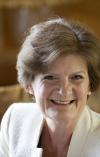The National Trust has doubled its turnover and significantly increased membership over the last 12 years. Dame Fiona Reynolds explains how becoming an ‘arms wide open’ organisation has brought about this success.

When I came to the National Trust as Director-General twelve years ago I knew we were good at looking after special places and conservation, but I felt we had started taking people’s support for granted. The challenge was keeping our reputation as a world-class conservation organisation, while becoming more people-focused, without compromising our conservation standards.
Modern audiences want to walk on the grass, touch things and engage in a truly tactile way
Early in my time in the post, I met some American National Park officials and I was very moved by their idea of ‘arms closed’ and ‘arms open’ organisations. Arms closed organisations keep things safe – visitors are allowed in but on the organisation’s terms. An arms open organisation wants people as part of its future, wonders what they think and wants them to get involved. In the last decade, the National Trust has become an arms open organisation, without losing its passion for conservation. In the process we have more than doubled our volunteers, doubled our turnover and increased our membership from 2.7 million to 4 million.
How did we do it? First, we looked at ourselves through the eyes of our audiences. As recently as 2003 we had never segmented our visitors. When we did, it was an epiphany: we identified three dominant segments, each very different from the others. Our property managers were set the challenge of tailoring experiences to the needs of people in each segment. Further research from members and supporters revealed that, while people respected the Trust, they felt little warmth towards us. They told us that the National Trust was ‘a good thing, but not their thing’. We realised we could not take their support for granted.
We began drawing out the spirit of each place. Modern audiences want to walk on the grass, touch things and engage in a truly tactile way. We decided to blow off the dust and bring our stories to life. We wanted to take away the ropes and the ‘do not touch’ signs and redesign visitor experiences from scratch. It is amazing – especially in places like Victorian kitchens – how much people can touch. We took a radical look at our opening hours, our outdoors offer and what we had online. In short, we learned to love people as much as places. This was a huge cultural change in an organisation that had been very arms closed, and has now become a core purpose – as core as our conservation purpose.
This change was partly brought about by my own passion for change, but importantly we put in place a classic balanced scorecard strategy. We constantly measure our audiences’ opinions. Our engagement key performance indicators (KPIs) – visitor enjoyment, member promoter score and relevance to local community ¬– are measured not by how well we think we are doing, but by other people’s views of us. Property managers receive new data every month, revealing not only visitor enjoyment levels, but also exactly where any problems lie. The Trust underwent radical cultural and structural change: our structures were re-engineered to focus on providing services to property managers, giving them decision-making powers and the freedom to experiment and to engage.
We are not there yet and perhaps we never will be, but today’s Trust feels very different from the one I walked into twelve years ago. It is true that we are still sometimes pictured just in terms of country houses and cream teas. It takes time to change the perception of an organisation, so we have to be creative and innovative, and keep our level of energy and commitment up. We now have engagement in our blood, and a vision for everyone to feel that the National Trust is not just a good thing, but also their thing.
Dame Fiona Reynolds is Director-General of the National Trust.
This article is based on Dame Fiona Reynolds’ closing keynote speech at the 2012 Arts Marketing Association conference (www.a-m-a.co.uk).




